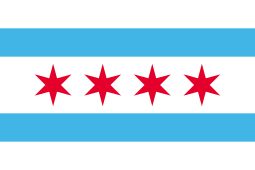Flag of Chicago
 | |
| Adopted | Original, 1917; additional stars added, 1933 and 1939. |
|---|---|
| Design | Four red stars between two light blue horizontal bars on a white field |
| Designed by | Wallace Rice |
The municipal flag of Chicago consists of two blue horizontal stripes or bars on a field of white, each stripe one-sixth the height of the full flag, and placed slightly less than one-sixth of the way from the top and bottom. Between the two blue stripes are four red, six-pointed stars arranged in a horizontal row.
The flag, designed by Wallace Rice, was adopted in 1917 after Rice won the design competition for the flag. The three sections of the white field and the two stripes represent geographical features of the city, the stars symbolize historical events, and the points of the stars represent important virtues or concepts. The historic events are Fort Dearborn, the Great Chicago Fire of 1871, the World's Columbian Exposition of 1893, and the Century of Progress Exposition of 1933–34.
In a review by the North American Vexillological Association of 150 American city flags, the Chicago city flag was ranked second best with a rating of 9.03 out of 10, behind only the flag of Washington, D.C.[1]
Symbolism
Stripes
The three white background areas of the flag represent, from top to bottom, the North, West and South sides of the city. The top blue stripe represents Lake Michigan and the North Branch of the Chicago River. The bottom blue stripe represents the South Branch of the river and the "Great Canal", over the Chicago Portage.[2] The lighter blue on the flag is variously called sky blue[3] or pale blue;[4] in a 1917 article of a speech by Rice, it was called "the color of water".[5]
Stars
There are four red six-pointed stars on the center white stripe. From left to right:
- The first star represents Fort Dearborn. It was added to the flag in 1939. Its six points symbolize transportation, labor, commerce, finance, populousness, and salubrity.[2]
- The second star stands for the Great Chicago Fire of 1871, and is original to the 1917 design of the flag. Its six points represent the virtues of religion, education, aesthetics, justice, beneficence, and civic pride.[2]
- The third star symbolizes the World's Columbian Exposition of 1893, and is original to the 1917 design. Its six points stand for political entities Chicago has belonged to and the flags that have flown over the area: France, 1693; Great Britain, 1763; Virginia, 1778; the Northwest Territory, 1789; Indiana Territory, 1802; and Illinois (territory, 1809, and state, since 1818).[2]
- The fourth star represents the Century of Progress Exposition (1933–1934), and was added in 1933. Its points refer to bragging rights: the United States' second largest city (became third largest in a 1990 census when passed by Los Angeles); Chicago's Latin motto, Urbs in horto ("City in a garden"); Chicago's "I Will" motto; the Great Central Marketplace; Wonder City; and Convention City.[2]
A possible fifth star has been proposed for the city flag on more than one occasion. The first occasion occurred in the 1940s, when a letter to the Chicago Tribune asked that a fifth star be added to the city flag in honor of the city's place in the history of the nuclear age.[6] On another occasion, a star was proposed in honor of Harold Washington, the first African-American mayor of Chicago.[7] A fifth star was also discussed following the Chicago Flood of 1992. Another fifth star was in the works from a group of Chicago real estate professionals to represent Chicago's entrepreneurial spirit in the early 1990s. A proposal was put forward by the 2016 Olympic Games Bid Committee; if the bid to host the games had been successful, a fifth star might have been added to the flag;[8] however, the Olympic bid was lost to Rio de Janeiro. In a more facetious vein, a fifth star has been proposed if the Chicago Cubs should win the World Series, which did not happen from 1908 to 2016.
Six-pointed stars are used because five-pointed stars represent sovereign states, and because the star as designed was not found on any other known flags as of 1917.[9]
History

In 1915, Mayor William Hale Thompson appointed a municipal flag commission, chaired by Alderman James A. Kearnes. Among the commission members were wealthy industrialist Charles Deering and impressionist painter Lawton S. Parker. Parker asked lecturer and poet Wallace Rice to develop the rules for an open public competition for the best flag design. Over a thousand entries were received. In the end, the commission chose the design by Wallace Rice himself. On April 4, 1917, the commission's recommendation was accepted by the city council.
References
- ^ "2004 American City Flags Survey", North American Vexillological Association press release, 2 October 2004
- ^ a b c d e "Chicago Facts: Municipal Flag". Chicago Public Library. Retrieved 2014-07-10.
- ^ "Chicago". Chicago magazine.
- ^ "Flying Colors: The Best and Worst of Flag Design". Print Magazine.
- ^ "Chicago Commerce". google.com.
- ^ http://introvert.net/2005/chiflag/bibliography.pdf
- ^ "Please, A Moratorium On Memorials". Chicago Tribune. 23 December 1987. Retrieved 18 January 2013. "Ald. Raymond Figueroa and others want a fifth star added to the city`s flag in memory of Mr. Washington."
- ^ http://chicago2016.org/News_story.aspx?NewsStory=9
- ^ Rice, Wallace; T. E. Whalen (22 July 2005). "Wallace Rice on Chicago Stars". introvert.net. Chicago. Retrieved 18 April 2011.
Further reading
- "Art and Architecture: How the Chicago Municipal Flag Came to be Chosen", Chicago Daily Tribune, July 17, 1921, p. 21.
- "City Gets New Flag Today with Third Star for 1933 Fair", Chicago Daily Tribune, October 9, 1933, p. 7.
- "Fort Dearborn Gets a Star on Chicago's Flag", Chicago Daily Tribune, December 22, 1939. p. 18.
